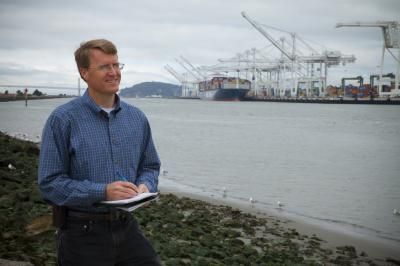Hydrogen powered prototype vessel for inland waterways
A high-tech propulsion system for the next 100 years
Environmentally friendly fuels are not just of interest for use in cars. The University of Birmingham has been operating a canal boat with a fuel cell drive for three years now. In the world of shipbuilding, however, different rules apply than those in the automobile or aircraft manufacturing industries. Weight is of practically no significance, but the propulsion plant must have an operating lifetime as long as that of the boat itself. The hydride storage system – the hydrogen tank – which must meet this challenging requirement was designed by Empa.
One of the most efficient means of transporting freight is by ship. However, many of the ships sailing today are powered by ageing diesel motors fitted with neither exhaust cleaning equipment nor or modern control systems. Three years ago the University of Birmingham initiated an ambitious trial, converting an old canal barge to use hydrogen fuel. The old diesel motor, drive system and fuel tank were removed and replaced with a high efficiency electric motor, a battery pack for short-term energy supply and a fuel cell with a hydrogen storage system to charge the batteries. In September 2007 the converted boat, the "Ross Barlow", was launched on its maiden voyage on Britain's 3500 km long canal system. Last year the barge made its longest voyage to date, of four days duration and 105 km length, negotiating no less than 58 locks. A good opportunity to look back and take stock.
Mass-produced drive system meets tailor-made storage technology
The first task to be done in converting the 18 m long steel-hulled barge was to calculate the power requirements. Based on experience with other battery driven canal boats it was decided to use a 10 kW permanent magnet motor. To provide energy for longer trips a commercial fuel cell delivering 1 kW of power was chosen. This system was originally designed as an uninterruptible power supply (UPS) for use in the telephone industry. The capacity of the fuel cell was, however insufficient to power the boat directly, so the “Ross Barlow” was also fitted with a 47 kWh buffer battery. Lead acid batteries were used for this purpose since they are low maintenance, low-priced and easy to charge. The weight of the battery pack is of no consequence when used in an inland waterways vessel.
The hydrogen supply for the fuel cell was provided by hydride storage system developed by Empa and partly financed by the Swiss Federal Office of Energy (SFOE). This device can store hydrogen with an energy content of 50 kWh, which is equivalent to 20 pressurized gas cylinders each of 10 Liter capacity. The storage material consists of an alloy of titanium, zirconium, manganese, vanadium and iron in powder form which is packed into sealed steel tubes. The powder absorbs hydrogen, thus acting as a storage medium, only releasing it when heated. Since when "filling up" with hydrogen the metal powder generates heat which must be removed, each storage module is located in a water tank which can be warmed or cooled as necessary, In addition the ship is fitted with a solar panel which can supply up to 320 W of electric power.
Charging and discharging cycles – for the next 100 years!
The journey through canals and locks makes widely varying demands on the barge’s electrical supply. To save wear and tear on the fuel cell, the motor draws its current from the lead acid batteries during routine sailing. A typical journey takes 4 to 6 hours during which time the canal boat uses 12 to 18 kWh of power. In continuous operation the fuel cell delivers 24 kWh of energy per day. This also powers the electronic monitoring system, leaving about 19 kWh with which to charge the buffer battery pack – enough energy for a daily journey lasting six hours. The reliability and operational lifetime of the metal hydride storage system was tested in the laboratory during its development. In practical terms this means that when used to power the "Ross Barlow", if the ship is assumed to travel 650 km per year through the British canal system, it would need refueling once a month with hydrogen. In this case the hydrogen storage system would have an operating lifetime in excess of 100 years, and would therefore comfortably outlast the useful lifetime of the barge itself.
The results of the test voyage
During the 105 km, four-day summer test journey a total of 106 kWh of electric energy was consumed on the "Ross Barlow", including lighting and recharging the crew’s mobile telephones and laptop computers.
The batteries supplied 71 per cent of this energy, the hydrogen fuel cell 25 per cent and the solar panel 4 per cent. There was unanimous praise from the crew for the practically silent way the boat sailed. Also notable was that when waiting in a lock the “Ross Barlow” was not engulfed by its own diesel fumes. The boat which accompanied it (which was about the same size) used some 50 L of diesel, resulting in a CO2 emission of approximately 133 kg. The “Ross Barlow” on the other hand produced no CO2 during its voyage, assuming that the hydrogen it used was derived from renewable sources and delivered free of emissions to the refueling point on the bank of the canal.
Other news from the department science
Most read news
More news from our other portals
See the theme worlds for related content
Topic World Battery Technology
The topic world Battery Technology combines relevant knowledge in a unique way. Here you will find everything about suppliers and their products, webinars, white papers, catalogs and brochures.

Topic World Battery Technology
The topic world Battery Technology combines relevant knowledge in a unique way. Here you will find everything about suppliers and their products, webinars, white papers, catalogs and brochures.
































































